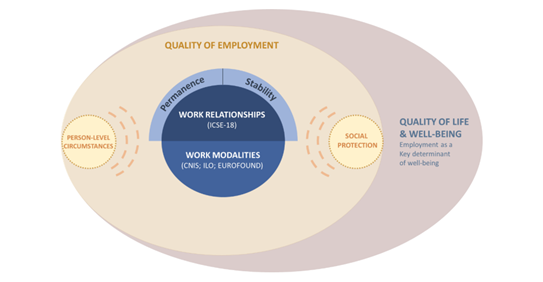
The Handbook on Forms of Employment, published today by UNECE, will help statisticians to assess the impacts of ever-increasing diversity in where, when, how and with whom we work.
The days of ‘working nine to five’ are, for many people, gone. In fact, the idea of having a stable, permanent, full-time job that entailed travelling to the same work location every weekday, to do a clearly-defined task, for a predictable income, might anyway be more of a fairy tale than a reality. But even more so in recent years, as the range of different kinds of jobs and working conditions increases.
It’s well-known that the pandemic has had a massive effect on working arrangements. Many of us began working from home, and for some this has now become the norm, as employees and employers alike have seen benefits to it. But even long before the pandemic things had already begun to change. The rise of the ‘gig economy’ and platform work, multi-layered sub-contractors, ‘digital nomads’ and ‘zero hours contracts’, among other changes, have changed the nature of work profoundly for many of today’s workers. Even the very definition of ‘employment’ has evolved, with those working right at the boundary between employment and self-employment—“independent workers”, to use the term recommended by the Handbook—being especially hard to define, such as those who contribute to a family business or dependent contractors.
The emergence and growth of these new forms of employment can be traced back to two long-term, worldwide economic trends; digitalization and the globalization of value chains. Work is increasingly done remotely, sometimes across borders. Businesses now often spread out their operations to access pools of workers with specialized skills, or to match workers with specific tasks.
With the spotlight shining squarely on these changes as the global community strives to recover from the pandemic, new questions are being asked about their long-term effects.
Assessing impacts
All of these changes bring with them questions and challenges when it comes to measurement. Measurement matters, because governments, businesses and individuals rely on figures such as employment rates, incomes and the size of the economy to make crucial economic decisions.
It’s not just about measuring the numbers of people in different kinds of jobs and how much they earn. Labour statistics serve a wide range of purposes, including informing policy decisions around social protection, ensuring that people are not exploited and that basic standards for quality of employment are safeguarded. Some new forms of employment could offer improved opportunities to balance work and personal life, with flexibility of hours or work location and reduced commute times. But unsocial hours and unpredictable earnings could have negative effects on well-being, while home-based work can raise questions of health and safety or the potential for social isolation, and short-term contracts or ‘gig work’ could risk exacerbating inequalities.
Statistics on new forms of employment are essential for monitoring how well our societies are living up to the promises of SDG 8, which calls for sustained, inclusive and sustainable economic growth, full and productive employment and decent work for all. This kind of assessment relies upon standardized, internationally-agreed definitions and methods to ensure countries are all counting the same thing, using comparable sources.
The Handbook puts forward a simple conceptual framework to help define and classify different forms of work, based principally on two factors: the relationship between workers and the economic unit for which they work (e.g. themselves, a company, etc.); and the way in which work is conducted.
The framework goes beyond this, however, to take into account the level of permanence or stability; the system of social protection; and employment circumstances; and the impacts of the employment on individual well-being.

Conceptual framework for understanding forms of employment
Using this framework as a starting point, the Handbook reviews the potential of different available data sources and proposes priority indicators for statistical offices to produce.
The Handbook was developed by an expert task force chaired by Canada, with ILO, Mexico, the United Kingdom, Singapore, Eurostat, Poland and Norway developing chapters of the Handbook, along with contributions from the Netherlands, European Labour Authority, United States of America, Slovenia, Germany, the Russian Federation and OECD. The Handbook was endorsed by the Conference of European Statisticians at its 70th session earlier this year.

